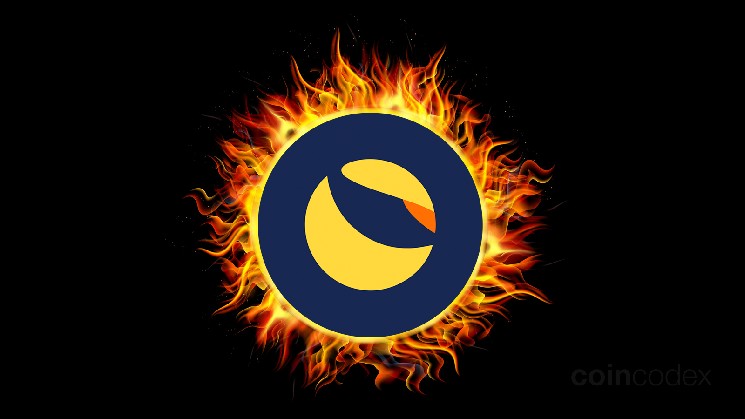As of June 2025, greater than 410 billion LUNC have been burnt, with a median every day burning charge of greater than 48 million over the past 30 days. Regardless of the excessive burn charge, there are nonetheless greater than 5.4 trillion LUNC in circulation, up from simply 380 million in Could 2022.
Following the collapse of the Terra Basic ecosystem in Could 2022, the availability of the native governance and utility token LUNC turned massively inflated, resulting in a monumental worth crash. Attempting to save lots of the ecosystem and restore the value of LUNC, the group handed a vote to enact a burn tax on all LUNC token transactions.
With that in thoughts, how do Terra Basic burns truly work? Will the LUNC burn tax handle to reign within the hyperinflated provide? What is the efficient LUNC tax charge? Learn alongside to seek out out.
Key takeaways in regards to the LUNC burn:
- The LUNC burn is a function of the Terra Basic community that sends 0.5% of every LUNC transaction to a burn pockets.
- The burn tax is used to scale back the hyperinflated provide of LUNC, which elevated from 400 million to over 6.5 trillion following the USTC de-peg in 2022.
- The tax was initially set at 1.2%, later lowered to 0.2%, and stands at 0.5% as of June 2025.
- Up to now, over 410 billion LUNC tokens have been despatched to the burn handle.
- On common, roughly 48 million LUNC tokens are burned every day (primarily based on information from the final month).
What led to the hyperinflated provide of LUNC?
Terra Basic is a decentralized, consensus-based blockchain protocol that operates on a safe proof-of-stake consensus mechanism. It has been designed to facilitate low-cost and safe transactions, with near-instant affirmation instances.
After USTC misplaced its $1 peg in Could, the availability of LUNC elevated drastically, attempting to revive the peg. However to no avail. When all was mentioned and performed, LUNC’s circulating provide elevated from lower than 400 million to over 6.5 trillion in a matter of 72 hours. Consequently, LUNC’s worth plummeted from over $100 in April to lower than 1 cent a couple of month later.
Within the aftermath, the unique blockchain rebranded to Terra Basic (LUNC). In the meantime, the unique Terra (LUNA) naming was assigned to a brand new blockchain that launched in June 2022 with no algorithmic stablecoin performance.
What’s the Luna Basic burn tax? Deflationary strain for LUNC
The LUNC burn is a singular coin burn function which is designed to scale back the circulating provide of tokens whereas growing their worth. The Terra Basic community has had a LUNC burn tax of 0.5% since Could 2023.
Initially, the LUNC burn charge was set to 1.2% of every transaction. The speed was later modified to 0.2% so as to encourage extra exercise on the blockchain. Nevertheless, the low tax charge had little or no impact on the circulating provide of LUNC. In March 2023, an energetic Luna group member filed a proposal to raise the LUNC tax charge to 0.5%.
The proposal to deliver the Luna Basic burn tax to 0.5% ultimately handed in Could 2023, with the backing of main crypto exchanges, together with Binance and KuCoin.
The Luna Basic burn mechanism works by robotically burning tokens each time a transaction happens on the community. The variety of tokens which are burned is relative to the variety of tokens in circulation. This ensures that the entire provide of tokens is continually lowering, thus growing their worth over time.
Fast abstract: By lowering the entire provide of tokens, demand for Luna Basic will increase, which results in an appreciation of token worth. As well as, the burn mechanism creates deflationary strain on the token, as the entire provide of tokens decreases over time.
The Luna Basic workforce has additionally developed a sequence of different mechanisms to extend the shortage of their tokens. These embody algorithmic buybacks which are triggered when sure circumstances are met, comparable to when the value goes above a predetermined stage. This helps to make sure that Luna Basic tokens stay scarce and useful for the long run.
Moreover, some exchanges like Binance are implementing the Luna Basic burn mechanism even on trades facilitated by the change. Because of this even when a commerce doesn’t happen instantly on the blockchain, tokens are nonetheless burned so as to safe the community.
When is the following Luna Basic burn and the place can I comply with the Luna Basic burn chart?
Over 410 billion LUNC have been burned to date, in line with the Luna Basic burn tracker. Supply
If you’re questioning when the following Luna Basic burn will happen, the reply is straightforward – Luna Basic burn is an automated, steady course of that’s being carried out every day.
The Luna Basic burn standing is tracked by varied web sites that present customers with a chart that shows the variety of tokens which were burned because the burn mechanism initially went stay, comparable to LUNC Burner. This permits customers to trace the burn progress and get a greater understanding of the burn mechanism.
The Luna Basic burn chart additionally shows details about when and what number of tokens have been burned for every transaction. This permits customers to maintain observe of the present state of Luna Basic tokens and their deflationary nature. By understanding the deflationary nature of Luna Basic tokens and their burn mechanism, customers can higher perceive why lowering the circulating provide is necessary for growing their worth over time.
It’s value noting that Binance, accounting for 70% of all buying and selling quantity within the area, has dedicated to finishing up LUNC burns on a month-to-month foundation. Each first day of the month, Binance calculates the entire quantity of LUNC to be burned primarily based on buying and selling charges from the earlier month and sends it to a burn handle.
What number of LUNC tokens have been burned to date? Luna Basic burn chart
As of June 2025, roughly 60.7% of burned LUNC got here from Terra Type Labs. Binance is the second-largest supply of LUNC burns, with 17.8% of the entire. Supply
The full quantity of LUNC tokens burned to date is roughly 410 billion, or roughly 6.3% of the entire provide. Binance has burned 72.9 billion LUNC tokens as of June 2025, whereas Terraform Labs has burned 249 billion.
It’s value noting that the speed of Luna Basic token burns decreased after proposal “5234” was enacted, which decreased tax burn from 1.2% to 0.2%. Nevertheless, a later proposal by “dfunk” (referred to as “New Financial Coverage for Terra Basic“) introduced the tax charge to 0.5%.
The every day LUNC burn charge is roughly $2,900 value of LUNC (in line with information from the final 30 days).
The LUNC burn is, nonetheless, not solely restricted to exchanges, however can also be carried out by the Luna Basic community itself. Because of this when a transaction happens on the blockchain, tokens are burned robotically. That is performed so as to make sure that the entire provide of tokens is continually lowering.
Here is a better take a look at what number of LUNC tokens have been burned to date:
- Complete LUNC burned: 410,419,163,993 LUNC
- LUNC burned on-chain: 71,335,537,236 LUNC
- Despatched to LUNC burn pockets instantly: 339,084,239,570 LUNC
- The full worth of burned LUNC: $25.10 million
The underside line: Can Luna Basic burns assist improve the value of LUNC?
The LUNC burn is a singular method to lowering the circulating provide of tokens and growing their worth over time. By burning a portion of tokens each time somebody trades on the blockchain, Luna Basic can cut back the entire variety of tokens in circulation and make sure that customers are rewarded for holding onto their cash. Many customers hope that the burn tax will likely be instrumental in serving to LUNC recuperate to its former glory.
Whereas it’s laborious to think about Luna Basic reaching $1 and even $0.10 given its present tokenomics (at $1, LUNC would have a market cap of over $5 trillion, which simply isn’t possible), LUNC may nonetheless have a brilliant future due to its enthusiastic group.









